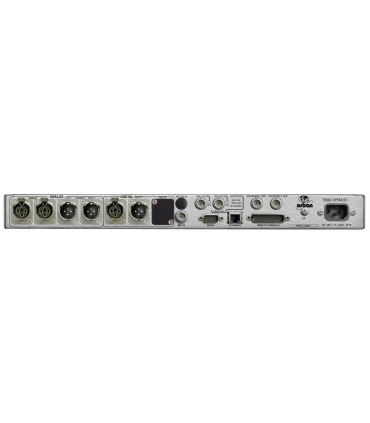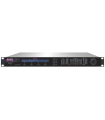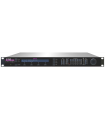OPTIMOD 5500i FM ONLY DIGITAL + RDS/RBDS
The OPTIMOD 5500i - Competitive OPTIMOD audio processing in a compact package at the most affordable price ever. OPTIMOD 5500i puts competitive five- and two-band OPTIMOD audio processing into a single rack unit and brings it to you at the most affordable price ever. Quality sound is what 5500i is all about - sound that attracts audiences by providing a polished, professional presentation regardless of format and source material. The 5500i can also be used as a superb stand-alone stereo encoder with latency as low as 2 ms and full overshoot limiting in both the left/right and composite baseband domains.
Women's clothing size
| Size | XS | S | M | L |
|---|---|---|---|---|
| Euro | 32/34 | 36 | 38 | 40 |
| USA | 0/2 | 4 | 6 | 8 |
| Bust(in) | 31-32 | 33 | 34 | 36 |
| Bust(cm) | 80.5-82.5 | 84.5 | 87 | 92 |
| Waist(in) | 24-25 | 26 | 27 | 29 |
| Waist(cm) | 62.5-64.5 | 66.5 | 69 | 74 |
| Hips(in) | 34-35 | 36 | 37 | 39 |
| Hips(cm) | 87.5-89.5 | 91.5 | 94 | 99 |
With your arms relaxed at your sides, measure around the fullest part of your chest.
Measure around the narrowest part of your natural waist, generally around the belly button. To ensure a comfortable fit, keep one finger between the measuring tape and your body.
Overview
When used in this mode, the 5500i must be driven (usually via an STL) by a full-featured FM audio processor (like Orban’s 8700i) that incorporates pre-emphasis-aware HF limiting and peak control.
The 5500i is the ideal choice for network broadcasters who process with Orban’s flagship OPTIMOD 8700i at the network origination point and who need a processor at every transmitter to eliminate STL overshoots (using the 5500i’s stand-alone stereo encoder mode) and/or to process local insertions while also eliminating network STL overshoots (using the 5500i’s audio processor / stereo encoder mode). Moreover, the 5500i’s two modes make it easy for large government and network broadcasters to manage its inventory of spares because any 5500i can be used as a stereo encoder with or without audio processing. Available in both modes, the built-in,vdefeatable ITU BS412 multiplex power controller allows the 5500i’s output to meet even the most stringent European government regulations.
Versatility doesn't stop with sound.
The 5500i includes a full-featured RBS/RBDS generator at no additional charge. The generator supports dynamic PS. It can be controlled via the 5500i presets and an ASCII terminal server that can be connected to automation to support displaying title and artist.
The 5500i has a 10 MHz frequency reference input allows the stereo pilot tone frequency to be locked to GPS or another high-accuracy frequency standard. This improves the performance of single-frequency networks in areas where coverage of the transmitters overlaps.
With the 5500i, your signature sound is just a preset away. An easy, one-knob Less/More adjustment allows you to customize any factory preset, trading cleanliness against processing artifacts according to the requirements of your market and competitive environment. Full Control gives you the versatility to customize your audio further.
This versaility makes the 5500i a superb choice for any format. Its five-band processing is ideal for any pop music format, while phase-linear two-band processing yields ultra-transparent sound for classical, classic jazz, and fine arts formats.
Unlike many lesser processors, the 5500i handles speech particularly well - it’s always clean, even when you process for loudness. If you’re concerned about latency because you need to feed live talent headphones off air, be assured that the 5500i’s ultra-low-latency (5 ms delay) processing will keep the most finicky talent happy. Or use optimum latency (15 ms delay) processing for the most competitive sound with delay that’s still low enough to satisfy most any talent.
The 5500i's built-in stereo encoder, AES/EBU digital inputs and outputs, and analog I/O permit hassle free interfacing to any broadcast plant, whether the 5500i is located at the studio or the transmitter. Tight band limiting to 15 kHz means you can use any uncompressed digital STL to pass 5500i - processed audio from studio to transmitter without compromising on-air loudness - there's no need to use STL's having 44.1 or 48 kHz sample-rate.
The stereo encoder's stereo sub-channel modulator can operate in normal double sideband mode and in an experimental compatible single sideband mode (SSB/VSB) that is offered to enable users to compare and assess the two modes.
Analog Fallback to digital control that allows Silence Sense to switch the active input from analog to digital if silence is detected in the analog input signal but not on the digital input signal. This function works vice versa as well on both analog and digital AES input. The silence sense parameters apply to both simultaneously and both detectors are available to drive the 5500i's tally outputs and sending SNMP Traps/Alerts.
Key Features
Quick Setup
Like the other OPTIMODs, the 5500i provides a guided setup procedure that helps you installing your unit.
Factory Presets & LESS-MORE Control
With a selection of factory presets and the simple LESS-MORE Control you can easily create your own signature sound. Orban is happy to help you find the perfect setup for your station.
Four Processing Structures
The 5500i features four processing structures which are Stand-Alone Stereo Encoder, Optimum Five-Band (or “Multiband”; 15 ms delay) for a consistent, “processed” sound, free from undesirable side effects, Ultra-Low-Latency Five-Band (5 ms delay), and Two-Band for a transparent sound that preserves the frequency balance of the original program material. The Optimum Five-Band and the Two-Band structures can be switched via a mute-free cross-fade. Please note that switching to or from the Ultra- Low Latency Five-Band structure causes the audio to mute for about two seconds because the DSP code must be reloaded.
ITU BS-412 Multiplex Power Control
A defeatable, programadaptive multiplex power limiter can unobtrusively control the multiplex power according to ITU-R BS412 standards.
Low-Delay DJ Monitor Output
The 5500i offers a low-delay monitor output which takes the audio from multiband compressor output and has an approximate delay of 4 ms. This allows the talent/DJ to comfortably monitor the processed audio off-air with headphones.
10 MHz Reference Input
A 10 MHz reference input allows the stereo pilot tone frequency and digital composite output sample rate to be locked to a 10 MHz reference signal (like GPS), facilitating single-frequency-network (SFN) and near-single-frequency-network (N-SFN) operation.
RDS
The 5500i has a built-in full-featured RDS/RBDS generator that supports static and dynamic RDS values.
Bypass Test Mode and Tone Generator
A Bypass Test Mode can be invoked locally, by remote control or by automation to perform a broadcast system test or to compare easily original and processed sound. A built-in line-up tone generator facilitates quick and accurate level setting.
Diversity Delay
A maximum delay of 16 seconds can be used as the diversity delay in HD Radio/DAB+ installations, which allows the 5500i’s stereo encoder (including composite limiter) to be used in an HD Radio/DAB+ installation.
SNMP Support
The SNMP (Simple Network Management Protocol) feature allows you to monitor your OPTIMOD’s status and to send alarm notifications via your OPTIMOD’s Ethernet connection to your network.
Remote Control or front panel operation
You can operate and configure the 5500i comfortably via the supplied Windows PC Software. Control is possible over your local network or the internet. It can also be operated easily by using its front panel and display.
Stereo Encoder functionality
The OPTIMOD 5500i allows changing between normal two-band and five-band audio processor modes and stand-alone stereo encoder modes via a smooth cross-fade. This facilitates switching between pre-processed network feeds (where only overshoot limiting is needed) and local origination (where full audio processing is required).
Specifications
Easy to use interface
- Configuration: Stereo.
- Impedance: Load impedance >10kΩ, electronically balanced
- Nominal input level: Software adjustable from -9.0 to +13.0 dBu (VU).
- Connectors: Two XLR type, female, EMI suppressed. Pin 1 to chassis ground, pin 2 (+) and 3 electronically balanced, floating and symmetrical.
- A/D conversion: 24 bit 128x over-sampled 24x delta sigma converter with linear phase aliasing filter. The converter emits a sampling frequency of 64 kHz, which the 5500i will then decimate to 32 kHz in DSP using a synchronous sampling frequency converter without high quality images. In strand-alone stereo encoder mode, the 64 kHz output of the converter is not sampled at the bottom.
- Filtering: RFI filtered
Analog audio output
- Configuration: Stereo. Flat or pre-format (at 50μs or 75μs), selectable via software.
- Source input: 50Ω, electronically balanced and floating.
- Load impedance: 600Ω or higher, balanced or unbalanced. Termination not required or recommended.
- Output level (100% peak modulation): Adjustable from -6 dBu to +24 dBu peak, in 600Ω or higher load, software selectable.
- Noise signal: >= 90 dB unweighted (Bypass mode, de-emphasized, bandwidth 20 Hz-15 kHz, referring to 100% modulation).
- L/R Crosstalk: <= -70 dB, 20 Hz-15 kHz.
- Distortion: <= 0.01% THD (Bypass mode, de-emphasized) bandwidth 20 Hz-15 kHz.
- Connectors: Two XLR types, male, EMI suppressed. Pin 1 chassis ground, pin 2 (+) and 3 electronically balanced, floating and symmetrical.
- D/A conversion: 24 bit 128x oversampling, with high pass filter at 0.15 Hz (-3 dB).
- Filtering: RFI filtered.
Digital audio input
- Configuration: Stereo according to AES3 standard, 24 bit resolution, software selection of stereo, mono from left, mono from right or mono from sum.
- Sampling frequency: 32, 44.1, 48, 88.2, or 96 kHz, automatically selected.
- Connector: XLR type, female, EMI suppressed. Frame ground pin 1, balanced and floating transformer pins 2 and 3, 110Ω impedance.
- Input reference level: Variable in the range from -30 dBFS to -10 dBFS.
- J.17 De-emphasis: Software selectable.
- Filtering: RFI filtered.
Digital audio output
- Configuration: Stereo according to AES3 standard. Output configured in the software as flat or pre-emphasized to the selected processing pre-emphasis (50μs or 75μs), with or without J.17 pre-emphasis.
- Sampling frequency: Free internal operation at 32, 44.1, 48, 88.2 or 96 kHz, selected in the software. Can also be synchronized to AES3 digital input at 32, 44.1, 48, 88.2 or 96 kHz, as configured in the software.
- Word length: Software selected for 24, 20, 18, 16 or 14 bit resolution. Optionally you can add the first order of high-pass dither in the form of noise, the dither level automatically adjusts appropriately for the word length.
- Connector: XLR type, male, EMI suppressed. Pin 1 to frame ground, pin 2 and 3 trans- ex-balanced and floating, impedance 110Ω.
- Output level (100% peak modulation): -20.0 to 0.0 dBFS software controlled. Filtering: RFI filtered.
Wordclock/10 MHz synchronization reference input
- Configuration: Accepts 1 x wordclock or 10 MHz reference signals, automatically selected. The DSP master clock can be synchronized to these signals, which in turn synchronizes the pilot tone frequency to 19 kHz, facilitating singe-frequency network operation. The digital output sampling frequency can also be locked to these signals.
- Level: The unit locks at 1 x wordclock and 10 MHz square and sine waves with a peak value from 0.5 V to 5.0 V.
- Connector: Female BNC, grounded to the chassis, not terminal to allow the reference signal loop via an external BNC tee connector (not supplied).
Composite base band output
- Configuration: Two outputs, each with independent output level control controlled by software, output amplifier and connector.
- Source impedance: 0Ω or 75Ω voltage source, selectable by jumper.
- Load impedance: 37Ω or higher. Termination not required or recommended.
- Maximum output level: +16.0 dBu (13.82Vp-p).
- Pilot Level: Adjustable from 6.0% to 12.0%, software controlled.
- Pilot stability: 19 kHz, ±1.0 Hz (10 degrees to 40 degrees C).
- D/A conversion: 24 bit
- Signal-to-noise ratio: >= 85 dB (Bypass mode, de-emphasized, bandwidth 20 Hz - 15 kHz, referred to 100% modulation, unweighted).
- Distortion: <= 0.02% THD (Bypass mode, de-emphasized, bandwidth 20 Hz - 15 kHz, referred to 100% modulation, unweighted).
- Stereo separation: > 50 dB, 30 Hz - 15 kHz. 60 dB typical at 400 Hz.
- Crosstalk-Linear:<= -80 dB, main to subchannel or subchannel to main (referred to 100% modulation).
- Sub-carrier protection (60-100 kHz): >= 70 dB (referred to 100% modulation; with composite limiter up to 2 dB; measured with 800 line FFT analyzer using "maximum peak hold" display).
- 57 kHz protection (RDS/RBDS): 50 dB relative to sub-carrier injection at 4%, ±2.0 kHz (with composite processing drive up to 2 dB).
- Connectors: Two BNC, shell connected to chassis ground, EMI suppressed.
- Maximum load capacity: 0.047 microfarad (source impedance 0Ω). Maximum cable length: 100 feet/30 meters RG-58A/U. Filtering: RFI filtered.
Subcarrier inputs (SCA)
- Configuration: Two sub-carrier inputs are added directly into the composite baseband outputs; the COMPx LVL control settings have no effect on the absolute levels of the sub-carrier.
- Impedance: 600Ω
- SCA Sensitivity: Variable from <100 mV p-p to >10 V p-p to produce 10% injection assuming 100% modulation = 4 V p-p at composite outputs of 5500. The adjustment potentiometers mounted on PC board, accessible from the rear panel, allow the user to adjust the sensitivity of the two SCA inputs.
- Connectors: Two BNC, shell connected to the chassis ground, EMI suppressed.
- 19 kHz pilot reference: The SCA2 input can be re-jumpered to provide a 19 kHz pilot reference output.
Remote computer interface
- Computer and operating system supported: IBM PC compatible with Microsoft Windows® 2000 (SP3 or higher) or XP, ME view 7, and 8, 8.1 and 10.
- Configuration: TCP/IP protocol via direct connection via cable, modem or Ethernet interface. A null modem cable suitable for direct connection is provided. The modem and other external equipment are not supplied.
- Serial connector:> RS-232 on DB-9 male connector, EMI suppressed. Uses PPP for direct or modem connection to the 5500i PC Remote application.
- Ethernet connector: RJ45 female connector for 10-1000 Mbps networks with CAT5 cabling. Native speed is 100 Mbps. Provides connection to the 5500i PC Remote application via a network or, using a crossover Ethernet cable, directly to a computer.
- Ethernet network standard: TCP/IP.
Remote Control Interface (GPI)
- Configuration: Eight (8) inputs, optoinsulated and floating.
- Voltage: 6-15V AC or DC, momentary or continuous. +12VDC supplied for ease of use with contact closure.
- Connectore: DB-25 male, EMI suppressed.
- Control: User programmable for any eight user presets, factory preset, bypass, test tone, stereo or mono mode, analog input, digital input.
Counting outputs
- Circuit configuration: Two NPN open collector outputs.
- Voltage: +15 volts maximum. Do not apply negative voltage. When driving a relay or other inductive load, connect a reverse polarity diode on the relay coil to protect the driver transistors from reverse voltage caused by inductive kickback.
- Current: 30 mA maximum
- Directions: Counting outputs can be programmed to indicate a number of different operating and fault conditions, including Input: Analog, Input: Digital, Analog Silent Input, AES Silent Input and AES Input Error.
Power Supply
- Voltage: 85-264 VAC, 50-60 Hz, 30 VA.
- Connector: IEC, EMI-suppressed. Detachable 3-wire power cord included.
- Fuse: > 2.5A 20mm HBC fast-acting 20mm HBC, mounted on the power supply circuit.
- Grounding: To meet EMI standards, the circuit ground is connected to the chassis ground.
- Safety Standards: ETL listed according to UL standards, CE marked.
Environmental
- Operating temperature: 32° to 122° F / 0° to 50° C for all operating voltage ranges.
- Humidity: 0-95% RH, non-condensing.
- Dimensions (W x H x D): 19" x 1.75" x 14.25" / 48.3 cm x 4.5 cm x 36.2 cm. One high rack unit.
- Humidity: 0-95% RH, non-condensing.
- RFI/EMI: Tested according to Cenelec procedures. FCC Device Part 15 Class A.
- Shipping Weight and Dimensions: 18 lbs. / 8.2 kg - 23" x 23" x 6".
Warranty
Five years, spare parts and service: Subject to the limitations of Orban.eare's Standard Warranty Agreement: <= -80 dB, from main to subchannel or from subchannel to main channel (referred to 100% modulation).










































